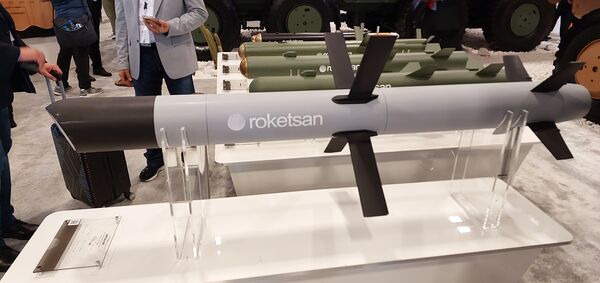
Roketsan UMTAS-GM ATGM (side view). In comparison with the original UMTAS, distinct differences are visible in the nose section and control surfaces. (Janes/Raghuraman CS)
Roketsan debuted its latest Long-Range Anti-Tank System – Future Combat System (Uzun Menzilli Tanksavar Sistemi – Geleceğin Muharebe Sistemi: UMTAS-GM) anti-tank guided missile (ATGM) at the 16th International Defence Industry Fair (IDEF) held in Istanbul from 25 to 28 July.
The company, which produces the UMTAS and L-UMTAS ATGMs, has optimised the latest variant for use by different platforms including airborne, naval, and land systems.
Development of the UMTAS-GM is a two-phase/block programme: UMTAS-GM Block-1 (dual-seeker) and UMTAS-GM Block-2 (hybrid-seeker).
UMTAS-GM Block-1, as displayed at IDEF 2023, is a long-range dual-seeker weapon system. It is an improved, heavier variant of UMTAS, and features imaging-infrared (IIR) and semi-active laser (SAL) seekers and a bidirectional radio frequency (RF) datalink. The missile has a cylindrical body with a flat nose and an aligned, cruciform fold-out wing and aft fin assembly.
Compared with the original UMTAS, the Block-1 variant has a flat (split-design) nose section, larger and improved control surfaces, and a slight increase in weight. The UMTAS-GM Block-1 is 1.72 m in length, 160 mm in diameter, and weighs 41.3 kg. It can be equipped with three warhead options – insensitive tandem anti-tank, high-explosive blast fragmentation, or thermobaric – to engage target sets at ranges from 1 km to 16 km, when fired from land vehicles/naval vessels, and from 1 km to 20 km when fired from helicopters.
Looking to read the full article?
Gain unlimited access to Janes news and more...







